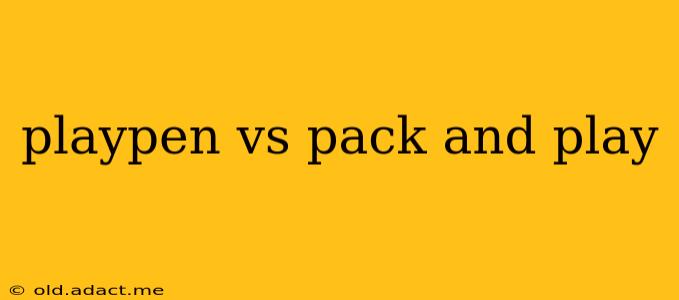Choosing between a playpen and a Pack 'n Play can feel overwhelming for new parents. Both offer safe spaces for your little one, but they have key differences that impact functionality and convenience. This comprehensive guide will break down the pros and cons of each, helping you make the best decision for your family's needs.
What is a Playpen?
A playpen is essentially a larger, often more substantial, enclosed space designed for babies and toddlers to play safely. They typically have mesh sides for ventilation and visibility, and are constructed from materials like sturdy plastic, wood, or metal. Playpens are generally more permanent fixtures and not easily portable.
Advantages of a Playpen:
- Larger Play Area: Playpens typically offer a more spacious environment than Pack 'n Plays, giving your child more room to move and play. This is especially beneficial for older babies and toddlers who are more mobile.
- Durability: Well-made playpens are robust and designed to withstand more wear and tear than Pack 'n Plays, potentially lasting longer through multiple children.
- Variety of Styles: Playpens come in a wider range of styles and designs, allowing you to choose one that complements your home décor.
Disadvantages of a Playpen:
- Less Portability: Playpens are bulky and difficult to move or transport, making them unsuitable for frequent travel or moving between rooms.
- Storage: They require significant storage space when not in use.
- Price: Playpens can be more expensive than Pack 'n Plays.
What is a Pack 'n Play?
A Pack 'n Play, often referred to as a portable crib or playard, is a multi-functional product that serves as a crib, playpen, and changing station all in one. Its defining characteristic is its portability and ease of setup and takedown, making it ideal for travel and smaller spaces.
Advantages of a Pack 'n Play:
- Portability: Pack 'n Plays are easily foldable and portable, making them perfect for travel, vacations, or use at grandparents' houses.
- Multi-Functional: Many models include features like a changing table, bassinet, and toy bars, offering versatility for various stages of your baby's development.
- Compact Storage: They fold down compactly for convenient storage.
- Affordability: Generally less expensive than stand-alone playpens.
Disadvantages of a Pack 'n Play:
- Smaller Play Area: The play area is significantly smaller than most playpens, potentially limiting your child's movement as they grow.
- Durability Concerns: While convenient, Pack 'n Plays might not be as durable as playpens and may not last as long.
- Potential for Cheaper Materials: Some Pack 'n Plays are constructed with less robust materials than higher-end playpens.
Playpen vs. Pack 'n Play: Which is Better?
The "better" choice depends entirely on your individual needs and priorities.
-
Choose a Playpen if: You prioritize a larger play area, durability, and a more permanent solution for your home. If you value style and don't anticipate frequent travel, a playpen is a good option.
-
Choose a Pack 'n Play if: Portability, multi-functionality, and ease of storage are your top priorities. If you need something convenient for travel or space-saving in a smaller home, a Pack 'n Play is a practical choice.
How much space do I need for a playpen?
The space needed for a playpen depends on the size of the playpen itself. Measure the dimensions of the playpen you're considering to ensure you have enough space in your home. Remember to allow for extra room around the playpen to ensure easy access for you and your child.
Are Pack 'n Plays safe for overnight sleeping?
Yes, most Pack 'n Plays are safe for overnight sleeping, provided they meet current safety standards and are used according to the manufacturer's instructions. Always check that the mattress is firm and fits snugly within the frame to reduce the risk of suffocation.
What are the best brands of playpens?
Many reputable brands manufacture both playpens and Pack 'n Plays. Researching individual brands and reading customer reviews can help you find a product that suits your needs and budget. Remember to always prioritize safety features when making your selection.
What age is a playpen suitable for?
A playpen's suitability depends on its size and features. Generally, playpens are suitable from infancy until a child is mobile enough to climb out. Always supervise children in playpens and ensure the design is appropriate for their age and development stage.
By carefully considering these factors and your personal circumstances, you can confidently choose the best option for your baby's safety and your family's lifestyle. Remember to prioritize safety and always follow the manufacturer's instructions for use.
